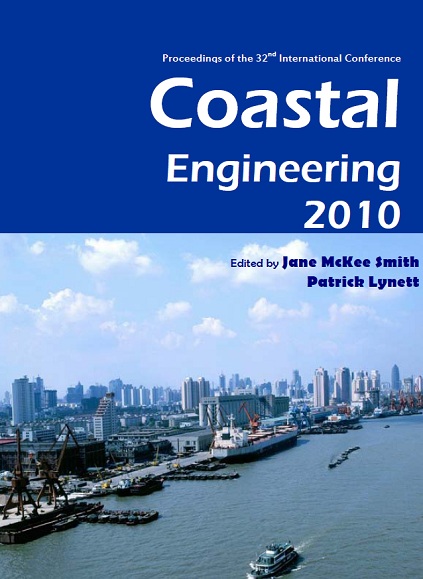Abstract
Japan has been constructing long coastal defense since the storm surge disaster with a loss of 5,000 lives by Typhoon Vera in 1959. The defense is designed for the storm water level including the storm surge of the standard typhoon based on Typhoon Vera. Stochastic typhoon model, simulating various typhoon track and intensity with Monte Carlo method, is one of useful tools to estimate the return period. According to recent research output the return period of the storm surge of the standard typhoon is near 100 years or more at three major bays in Japan. But there is uncer-tainty by some of parameters and models in the stochastic simulation. Sea surface drag coefficient under high wind speed and future change in typhoon intensity and track are critical to extreme values of the storm surges.References
Hashino, M. and Y. Kuwata. 1987. Evaluation of concurrent characteristics of rainfall and storm surge by a stochastic typhoon model, Journal of Natural Disaster Science, Vol.9, No.1, pp 79-97.
Hashimoto, N., H. Kawai and K. Matsuura. 2004. Development of stochastic typhoon model for performance design of coastal structures, Proceedings of 29 th International Conference on Coastal Engineering, ASCE, Melbourne, Australia, pp 3615-3627.
International Conference on Coastal Engineering, ASCE, Vol 2, pp 1389-1402.
Hatada, Y. and M. Yamaguchi. 1996. A Stochastic Typhoon Model and its Application to the Estimation of Storm Surge and Wave Height, Proceedings of 25 th
Kato, F., K. Torii, H. Shibaki and K. Suzuyama. 2003. Probabilistic estimation of tide levels and wave overtopping rates using a stochastic typhoon model, Proceedings of Coastal Engineering, JSCE, vol.50, pp.291-295, in Japanese.http://dx.doi.org/10.2208/proce1989.50.291
Kawai, H. and S. Takemura. 2002. Simultaneity of maximum storm surge and wave caused by typhoon in Tokyo Bay, Japan, Proceedings of 28 th International Conference on Coastal Engineering (ICCE2002), ASCE, Vol 1, pp 1216-1228.
Kawai, H., N. Hashimoto and K. Matsuura. 2006. Improvement of stochastic typhoon model for the purpose of simulating typhoons and storm surges under global warming, Proceedings of 30 th International Conference on Coastal Engineering (ICCE2006), ASCE, San Diego, USA, Vol 2, pp 1838-1850.
Kawai, H., S. Takahashi, T. Hiraishi, N. Hashimoto and K. Matsuura. 2007. Lessons learned from recent storm surge disasters and estimation of extreme tidal levels for coastal defense performance by using stochastic typhoon model, Proceedings of 17 th (2007) International Ocean and Polar Engineering Conference, ISOPE, Vol 3, pp 1792-1799.
Kawai, H., N. Hashimoto and K. Matsuura. 2008a. Estimation of extreme storm water level in Japanese bays by using stochastic typhoon model and tide observation data, Proceedings of the 18 th (2008) International Offshore and Polar Engineering Conference, ISOPE, Vol.3,pp.543-550.
Kawai, H., N. Hashimoto and K. Matsuura. 2008b. Estimation of extreme storm surge and its duration in Japanese bays by using stochastic typhoon model, Proceedings of the 31 st International Conference on Coastal Engineering (Poster-paper), ASCE.
Kawai, H., N. Hashimoto and M. Yamashiro. 2009. Real-time Probabilistic Prediction of storm water level at Japanese ports, Proceedings of the 19 th (2009) International Offshore and Polar Engineering Conference, ISOPE, Vol.3, pp.784-791.
Mitsuyasu, H. and T. Kusaba. 1984. Drag coefficient over water surface under the action of strong wind, Journal of Natural Disaster Science, Vol.6-2, pp.43-50.
Mitsuta, Y. and T. Fujii. 1987. Analysis and synthesis of typhoon wind pattern over Japan, Bulletin Disaster Prevention Research Institute, Kyoto University, Vol.37, Part 4, No.329, pp.169-185.
Myers, V.A. and W. Malkin. 1961. Some properties of hurricane wind fields as deduced from trajectories, United States Weather Bureau, National Hurricane Research Project, Report 49.
Nonaka, H., M. Yamaguchi, Y. Hatada and Y. Itoh. 2000. A system for estimating extremes of wave height using an extended stochastic typhoon model, Proceedings of Coastal Engineering, JSCE, vol.47, pp.271-275, in Japanese. http://dx.doi.org/10.2208/proce1989.47.271
Oouchi, K., J. Yoshimura, H. Yoshimura, R. Mizuta, S. Kusunoki, and A. Noda. 2006. Tropical cyclone climatology in a global-warming climate as simulated in a 20 km-mesh global atmospheric model: frequency and wind intensity analyses, Journal of the Meteorological Society of Japan, 84-2, pp.259-276.
Powell, M. D., P. J. Vickery and T. A. Reinhold. 2003. Reduced drag coefficient for high wind speeds in tropical cyclones, Nature, Vol.422. http://dx.doi.org/10.1038/nature01481
Rumpf, J., E. Rauch, V. Schmidt and H. Weindl. 2006. Stochastic modeling of tropical cyclone track data, 27th Conference on Hurricanes and Tropical Meteorology, AMS, 5A-6.
Takahashi, S., H. Kawai and T. Takayama. 2002. Storm surge disaster by typhoon No.9918 -performance design of coastal defense-, Proceedings of Solutions to Coastal Disasters Conference 2002, ASCE, San Diego, USA, pp 735-749. http://dx.doi.org/10.1061/40605(258)64
Zhang, W., W. Perrie and W. Li. 2006. Impact of waves and sea spray on midlatitude storm structure and intensity, Monthly Weather Review, AMS, Vol. 134, pp.2418-2442. http://dx.doi.org/10.1175/MWR3191.1

